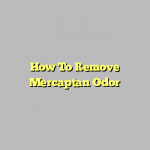
Also known as thiols, mercaptan is a harmless but highly pungent and foul-smelling gaseous substance. It is found in many industrial wastes and it also can be present in gaseous and liquid wastes. Some forms of mercaptan could be toxic but the toxic variants are found in very low concentrations. They can be easily detected because of the overpowering smell and even when they are present in small quantities the smell will be quite strong. However, they need to be present in significantly large quantities for them to be toxic and harmful for human beings and other living creatures. In most cases, they are not considered hazardous but are rather looked at a horrible nuisance because of its foul smell. You need to bear in mind that the odor detection levels are calculated in the order of PPB or parts per billion. Hence, this certainly would give you an idea as to how badly smelling is mercaptan. Hence it is quite obvious that there should be ways and means that could help to control mercaptan quite effectively. While there are many such ways, in this article we will be looking at the use of hydrogen peroxide for the purpose of effectively controlling mercaptan.
How Is It Effective
Hydrogen peroxide has been considered as a safe and reliable option for oxidizing thiols and that too across a range of temperatures and also in different concentrations. However, there could be a need for using catalysis for vigorous oxidation. Before going through the use of hydrogen peroxide for removing mercaptan, we should have some basic understanding of the sources of thiols or mercaptan. When the Kraft pulping process takes place, methanethiol is formed as a byproduct. This happens because of the demethylation of a substance known as lignin. Additionally, in various petroleum products thiols come into being because of the decomposition of various agents that are rich in sulfur. This happens during the refining process.
On the other hand, thiols do have their own areas of applications. They are used in ore floatation and are also used and are converted into byproducts in different types of chemical manufacturing processes. These include insecticides, pharmaceuticals, rubber additives, wetting agents and plastics. Thiols or mercaptan is formed when bacterial decomposition happens as far as organic materials are concerned. These are typically found in sewage treatment plants and also in the rendering industry.
Treatments Using Hydrogen Peroxide
Hydrogen peroxide can be useful for removing mercaptan from natural gas and liquids. This is done by a process of mild oxidation. This creates a reaction and it happens once the mixing has been done. The products and compounds, including hydrogen peroxide, are water-insoluble and they form an oily layer. Hence they can be readily separated and once the separation process has been done you have only trace amounts of odorous materials. However, the weight ratio of hydrogen peroxide to that of thiols has to be correct and only experts would be able to determine the ratio.
Hence at the end of the day, there is hardly any doubt that while mercaptan is an unavoidable byproduct in various areas, hydrogen peroxide could be easily used for completely eliminating the thiols.-
Contact US:
Chemical Products Industries, Inc. Address: 7649 SW 34th St, Oklahoma City, OK Phone: (800) 624-4356